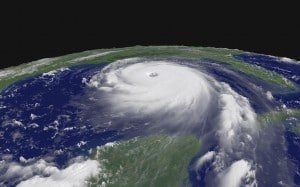It’s official, guys.
It is Hurricane Season.
Okay, so it’s been hurricane season. The 2012 Atlantic and Caribbean hurricane season began on June 1 and ends November 30. The Eastern Pacific hurricane season kicked off May 15 and wraps up November 30.
So maybe we’re a little late to the party.
But according to FEMA, peak hurricane season is right around the corner: running from mid-August to October.
According to the National Hurricane Center, it’s nearly impossible to determine a storm’s approach any sooner than 5 or 7 days in advance.
If you had only 5 days warning, would you be ready?
Between 1970 and 1999, more people lost their lives from freshwater inland flooding associated with tropical cyclones than from any other weather hazard related to such storms. (https://www.ready.gov/hurricanes)
Protect yourself. Protect your family. Protect your home.
There is plenty you can do BEFORE a storm even hits. So next time you have a few hours on a Sunday, work on preparing your home for the risk of a hurricane. Here are some tips:
Before a Hurricane:
- Build an emergency kit. Tips for building the kit can be found here
- Learn the elevation of your property and whether it is flood-prone
- Study community hurricane evacuation routes
- Know where you would go if a hurricane hit
- Make a plan on how to evacuate. A downloadable Family Emergency Plan can be found here. Print it off and complete it.
- Practice your plan
- Develop a plan for your pet. A great list of steps and supplies from the Federal Alliance for Safe Homes (FLASH) can be found here.
- Don’t forget about your business. Hurricane preparation does not end at home. Here is a great Business Survival Plan from the National Hurricane Survival Initiative
- Pay attention to the news. Know the guidelines of when you should evacuate and when you should stay. A good guide from the National Hurricane Survival Initiative can be found here.
- Cover all your home’s windows.
- Brush up on your watches and warning terms. That way, you’ll understand the risk and can better make safety and evacuation decisions. A good review from FLASH can be found here.
- Install straps or clips to securely fasten your roof to your frame structure to reduce wind damage
- Keep trees well-trimmed
- Clear loose/clogged rain gutters
- Reinforce garage doors
- Bring in ALL outdoor furniture, decorations, garbage cans and similar items that are not tied down
- If you live in a high rise, prepare to take shelter on or below the 10th floor
- Print out and LAMINATE (to protect from water), tips for what to do during and after a hurricane and put them with your safety kit. You can find “during and after a hurricane” tips here.
- Check your property insurance policy for appropriate coverage. Here’s some information on California Casualty’s coverage and here’s some information on flood insurance an important factor in Hurricane recovery.
As peak Hurricane season begins, make sure you are ready for possible storms. Your safety is our top priority.
Here are some additional resources we recommend:
- The Federal Alliance for Safe Homes (FLASH) has a fantastic site on disaster preparedness. They have great resources, checklists and plans for preparing your home and family for a hurricane.
- The National Hurricane Survival Initiative offers another great checklist for your safety kits, and most of their forms are downloadable! Check them out here.
- The National Weather Service’s National Hurricane Center is a great place to monitor hurricane weather as it develops. They also have good preparedness resources and can help you find your local emergency management office
- Educators Receive $1,000 Athletic Grants from California Casualty - May 22, 2024
- Music & Arts Grant Recipients – 2023 - December 1, 2023
- How to Tell When You Need New Brakes - November 20, 2023

